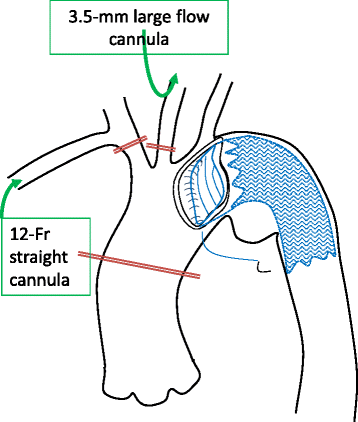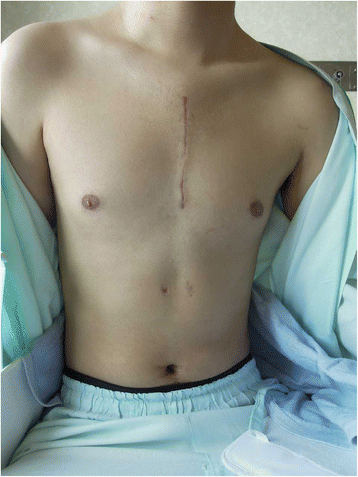Open stent graft repair with upper-half Sternotomy for blunt thoracic aortic injury: a case report
- PMID: 29187218
- PMCID: PMC5708079
- DOI: 10.1186/s13019-017-0667-4
Open stent graft repair with upper-half Sternotomy for blunt thoracic aortic injury: a case report
Abstract
Background: Thoracic endovascular aortic repair is now widely applied to the treatment of blunt aortic injury. However, its long-term outcomes remain unclear. Endoleakage and migration might occur in the long term, especially when younger patients undergo endovascular aortic repair. In open stent grafting, the proximal end of the open stent graft is directly sutured to the native aorta, which may reduce the risk of endoleakage and migration. We applied open stent grafting to the treatment of blunt aortic injury in the subacute phase and herein report the patient's clinical course.
Case presentation: A 20-year-old man with a developmental disorder collided with a steel tower while skiing. He was transferred to our hospital by helicopter. X-ray examination and computed tomography revealed fractures of left humeral head and femoral neck and aortic isthmus dissection. We did not perform an acute-phase operation because of the presence of multiple trauma and instead performed open stent grafting with an upper-half sternotomy 42 days after the injury. He recovered uneventfully without psychological problems other than his preexisting developmental disorder. No endoleakage or aneurysm was observed during an 18-month follow-up period.
Conclusions: Open stent grafting might be an alternative to open surgery and thoracic endovascular aortic repair for blunt chest trauma, although intensive follow-up is needed.
Keywords: Aortic dissection; Blunt thoracic aortic injury; Multiple trauma; Open stent graft; Thoracic endovascular aortic repair.
Conflict of interest statement
Ethics approval and consent to participate
The patient has provided permission to publish these features of his case, and the identity of the patient has been protected.
Consent for publication
Written consent was obtained from the patient before starting preparation for the manuscript.
Competing interests
All the authors have read the manuscript and have approved of its submission. The authors report no conflicts of interest.
Publisher’s Note
Springer Nature remains neutral with regard to jurisdictional claims in published maps and institutional affiliations.
Figures





Similar articles
-
Management of blunt traumatic thoracic aorta injuries with endovascular stent-grafts in a tertiary hospital in an urban Asian city.Ann Vasc Surg. 2011 Jul;25(5):605-11. doi: 10.1016/j.avsg.2010.12.009. Epub 2011 Mar 24. Ann Vasc Surg. 2011. PMID: 21435831
-
The evolution of care improves outcome in blunt thoracic aortic injury: A Western Trauma Association multicenter study.J Trauma Acute Care Surg. 2017 Dec;83(6):1006-1013. doi: 10.1097/TA.0000000000001555. J Trauma Acute Care Surg. 2017. PMID: 28538630
-
Results of a multicenter, prospective trial of thoracic endovascular aortic repair for blunt thoracic aortic injury (RESCUE trial).J Vasc Surg. 2013 Apr;57(4):899-905.e1. doi: 10.1016/j.jvs.2012.10.099. Epub 2013 Feb 4. J Vasc Surg. 2013. PMID: 23384495 Clinical Trial.
-
When and how should we manage thoracic aortic injuries in the modern era?Interact Cardiovasc Thorac Surg. 2016 Dec;23(6):970-975. doi: 10.1093/icvts/ivw247. Epub 2016 Aug 29. Interact Cardiovasc Thorac Surg. 2016. PMID: 27572614 Review.
-
Endovascular repair of traumatic thoracic aortic disruption.Perspect Vasc Surg Endovasc Ther. 2006 Jun;18(2):132-9. doi: 10.1177/1531003506293453. Perspect Vasc Surg Endovasc Ther. 2006. PMID: 17060230 Review.
Cited by
-
Beyond the Slopes and Highways: Endovascular Repair of Blunt Traumatic Aortic Injuries after Skiing versus Motor Vehicle Accidents.J Clin Med. 2024 Jun 4;13(11):3315. doi: 10.3390/jcm13113315. J Clin Med. 2024. PMID: 38893026 Free PMC article.
References
-
- Fox N, Schwartz D, Salazar JH, Haut ER, Dahm P, Black JH, et al. Evaluation and management of blunt traumatic aortic injury: a practice management guideline from the eastern Association for the Surgery of trauma. J Trauma Acute Care Surg. 2015;78:136–146. doi: 10.1097/TA.0000000000000470. - DOI - PubMed
Publication types
MeSH terms
LinkOut - more resources
Full Text Sources
Other Literature Sources
Medical

